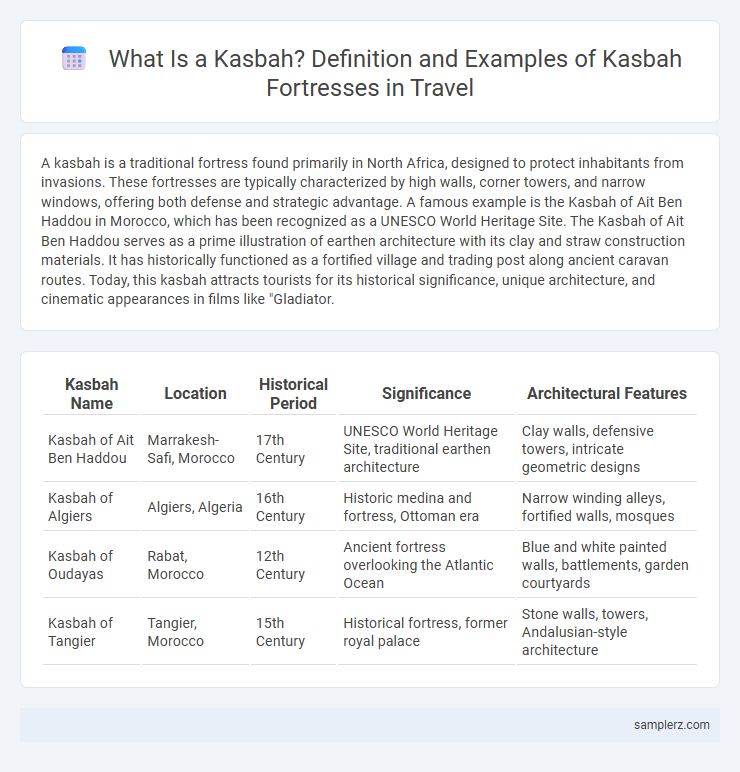A kasbah is a traditional fortress found primarily in North Africa, designed to protect inhabitants from invasions. These fortresses are typically characterized by high walls, corner towers, and narrow windows, offering both defense and strategic advantage. A famous example is the Kasbah of Ait Ben Haddou in Morocco, which has been recognized as a UNESCO World Heritage Site. The Kasbah of Ait Ben Haddou serves as a prime illustration of earthen architecture with its clay and straw construction materials. It has historically functioned as a fortified village and trading post along ancient caravan routes. Today, this kasbah attracts tourists for its historical significance, unique architecture, and cinematic appearances in films like "Gladiator.
Table of Comparison
| Kasbah Name | Location | Historical Period | Significance | Architectural Features |
|---|---|---|---|---|
| Kasbah of Ait Ben Haddou | Marrakesh-Safi, Morocco | 17th Century | UNESCO World Heritage Site, traditional earthen architecture | Clay walls, defensive towers, intricate geometric designs |
| Kasbah of Algiers | Algiers, Algeria | 16th Century | Historic medina and fortress, Ottoman era | Narrow winding alleys, fortified walls, mosques |
| Kasbah of Oudayas | Rabat, Morocco | 12th Century | Ancient fortress overlooking the Atlantic Ocean | Blue and white painted walls, battlements, garden courtyards |
| Kasbah of Tangier | Tangier, Morocco | 15th Century | Historical fortress, former royal palace | Stone walls, towers, Andalusian-style architecture |
Introduction to Kasbahs: Defining Fortress Architecture
Kasbahs are traditional North African fortress structures characterized by high walls, corner towers, and fortified gates designed for defense and protection. These architectural marvels often incorporate intricate geometric patterns and local materials such as mudbrick and stone, reflecting regional building techniques. Historically, kasbahs served as both military strongholds and administrative centers, highlighting their strategic and cultural importance in desert landscapes.
Historical Significance of Kasbah Fortresses
Kasbah fortresses, such as the iconic Kasbah of Ait Ben Haddou in Morocco, exemplify ancient defensive architecture that protected trade routes and local populations. These structures served as strategic military outposts and administrative centers during the medieval period, reflecting the socio-political dynamics of North African empires. Preserving kasbahs offers valuable insights into historical urban planning, cultural heritage, and architectural innovation in fortress design.
Unique Architectural Features of Kasbahs
Kasbahs are distinguished by their massive earthen walls crafted from rammed earth or adobe, designed to withstand harsh desert climates while providing natural insulation. Intricate geometric patterns and intricately carved wooden doors showcase the artistic heritage of Berber and Arab cultures. Their strategic towers and narrow, winding alleys create both defensive strength and a labyrinthine layout unique to North African fortresses.
Kasbah Aït Benhaddou: Morocco’s Iconic Fortress
Kasbah Ait Benhaddou, a UNESCO World Heritage site in Morocco, exemplifies traditional earthen architecture and serves as a striking fortress along the ancient caravan route between the Sahara and Marrakech. This iconic kasbah features tall defensive walls, intricate corner towers, and labyrinthine alleyways, showcasing the ingenuity of Berber construction techniques. Its cultural significance and cinematic presence in films like "Gladiator" and "Game of Thrones" attract travelers seeking authentic historical and architectural experiences.
Kasbah of the Udayas in Rabat: A UNESCO World Heritage Site
The Kasbah of the Udayas in Rabat stands as a remarkable example of Moroccan fortress architecture, featuring imposing defensive walls and traditional Andalusian gardens. This UNESCO World Heritage Site dates back to the 12th century and offers panoramic views of the Atlantic Ocean and the Bou Regreg River. Visitors can explore its narrow alleys, historical mosque, and vibrant Andalusian-style houses that reflect centuries of cultural heritage.
Kasbah Amridil: Preserving Berber Heritage
Kasbah Amridil, nestled in the Skoura Oasis of Morocco, exemplifies traditional Berber architecture with its towering earthen walls and intricate geometric designs. This historic fortress, dating back to the 17th century, serves as a cultural museum that preserves the rich heritage of the Berber people and reflects their ancient way of life. Visitors to Kasbah Amridil experience authentic Moroccan history through its well-preserved rooms, ancestral artifacts, and stunning palm grove surroundings.
Toubkal Kasbah: Gateway to the High Atlas Mountains
Toubkal Kasbah, located near the base of Jebel Toubkal--the highest peak in the High Atlas Mountains--is an iconic fortress offering travelers a unique blend of traditional Berber architecture and modern hospitality. Serving as a gateway for trekking expeditions, the kasbah provides stunning panoramic views, authentic local cuisine, and cultural immersion in Berber village life. Its strategic location makes it an essential stop for adventurers exploring Morocco's mountainous terrain and seeking an authentic Atlas foothills experience.
Restoration Efforts in Ancient Kasbah Fortresses
Restoration efforts in ancient kasbah fortresses, such as the iconic Kasbah of Ait Benhaddou in Morocco, focus on preserving traditional earthen architecture while reinforcing structural stability. Experts employ techniques like mud-brick repair and use local materials to maintain historical authenticity and withstand environmental challenges. These conservation projects aim to protect UNESCO World Heritage sites, enhancing cultural tourism and safeguarding heritage for future generations.
Kasbahs as Modern Tourist Attractions
Kasbahs, such as the iconic Kasbah of Algiers and the historic Kasbah of Ait Benhaddou in Morocco, have transformed into vibrant modern tourist attractions. These ancient fortress complexes offer visitors a glimpse into North African heritage through their well-preserved architecture, traditional markets, and cultural festivals. Tourism development around kasbahs has boosted local economies while preserving their unique historical significance.
Experiencing Culture and History in Kasbah Fortresses
Kasbah fortresses, such as the iconic Kasbah of Ait Ben Haddou in Morocco, offer immersive experiences into traditional Berber culture and ancient architectural techniques. Visitors can explore winding alleyways, centuries-old clay walls, and historic watchtowers that reveal the strategic significance of these structures. Engaging with local guides and artisans provides deep insights into the heritage and daily life preserved within these fortified settlements.

example of kasbah in fortress Infographic
 samplerz.com
samplerz.com